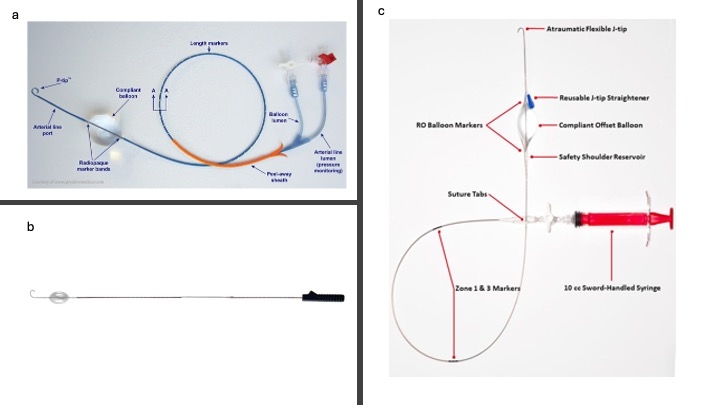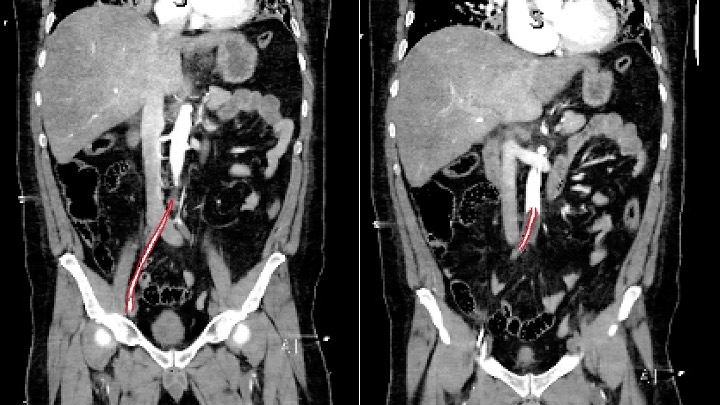Final ID: Sa301
Successful Deployment of Resuscitative Endovascular Balloon Occlusion of the Aorta by Emergency Medicine Physicians for Refractory Non-Traumatic Out of Hospital Cardiac Arrest
Abstract Body: Introduction/Background
Resuscitative endovascular balloon occlusion of the aorta (REBOA), initially developed to manage non-compressible torso hemorrhage, is a promising intervention for enhancing coronary and cerebral perfusion in non-traumatic cardiac arrest. This procedure can increase rate of return of spontaneous circulation (ROSC) or serve as a bridge to extracorporeal cardiopulmonary resuscitation (ECPR).
Research Questions/Hypothesis
We hypothesized that emergency physicians, following an educational program including didactics, simulation, and live tissue trainings, would demonstrate successful and safe REBOA placement in adults with out-of-hospital cardiac arrest (OHCA).
Goals/Aims
This study aims to evaluate the first-pass success rate of REBOA placed by trained emergency physicians during treatment of OHCA in the emergency department.
Methods/Approach
This was a retrospective review of emergency physician-placed REBOA devices. Five board-certified Emergency Medicine attending physicians were trained using didactics, hands-on simulations, and live tissue training in pigs, followed by an objective competency assessment using the REBOA Rating of Skills tool (REBOA-RATE). REBOA device selection was based on availability within the emergency department.
Patient Selection: Patients were selected based on provider discretion, specifically those who did not meet institutional ECPR criteria. Inclusion criteria included patients aged 18-80 with a witnessed arrest who had received at least 15 minutes of standard advanced cardiac life support interventions. Exclusion criteria included known end-stage organ disease, trauma, or dementia.
Results/Data:
Eight patients, 5 males and 3 females (age range 25-79), underwent REBOA placement. First pass success was 8/8 (100%) REBOA catheters from all 3 commercially available catheters in the United States were used. ROSC was achieved in 3/8 (37.5%) patients, although all patients died after hospital admission. No REBOA associated complications were identified on imaging or autopsy reports.
Conclusions:
All REBOA placements performed by trained emergency physicians in patients with OHCA were successful after our training protocol, resulting in ROSC in 37.5% with no long term survivors. Based on the demonstrated success rate, we hope to further examine the feasibility and utility of REBOA in the pre-hospital setting for patients with refractory cardiac arrest as a bridge to earlier ROSC or additional ECPR therapies.
Resuscitative endovascular balloon occlusion of the aorta (REBOA), initially developed to manage non-compressible torso hemorrhage, is a promising intervention for enhancing coronary and cerebral perfusion in non-traumatic cardiac arrest. This procedure can increase rate of return of spontaneous circulation (ROSC) or serve as a bridge to extracorporeal cardiopulmonary resuscitation (ECPR).
Research Questions/Hypothesis
We hypothesized that emergency physicians, following an educational program including didactics, simulation, and live tissue trainings, would demonstrate successful and safe REBOA placement in adults with out-of-hospital cardiac arrest (OHCA).
Goals/Aims
This study aims to evaluate the first-pass success rate of REBOA placed by trained emergency physicians during treatment of OHCA in the emergency department.
Methods/Approach
This was a retrospective review of emergency physician-placed REBOA devices. Five board-certified Emergency Medicine attending physicians were trained using didactics, hands-on simulations, and live tissue training in pigs, followed by an objective competency assessment using the REBOA Rating of Skills tool (REBOA-RATE). REBOA device selection was based on availability within the emergency department.
Patient Selection: Patients were selected based on provider discretion, specifically those who did not meet institutional ECPR criteria. Inclusion criteria included patients aged 18-80 with a witnessed arrest who had received at least 15 minutes of standard advanced cardiac life support interventions. Exclusion criteria included known end-stage organ disease, trauma, or dementia.
Results/Data:
Eight patients, 5 males and 3 females (age range 25-79), underwent REBOA placement. First pass success was 8/8 (100%) REBOA catheters from all 3 commercially available catheters in the United States were used. ROSC was achieved in 3/8 (37.5%) patients, although all patients died after hospital admission. No REBOA associated complications were identified on imaging or autopsy reports.
Conclusions:
All REBOA placements performed by trained emergency physicians in patients with OHCA were successful after our training protocol, resulting in ROSC in 37.5% with no long term survivors. Based on the demonstrated success rate, we hope to further examine the feasibility and utility of REBOA in the pre-hospital setting for patients with refractory cardiac arrest as a bridge to earlier ROSC or additional ECPR therapies.
More abstracts on this topic:
Acceptability and Effectiveness of a Novel, Video-Based CPR and AED Education Program in Canadian Schools
Allan Katherine, Dhillon Santokh, Mcculloch Holly, Ruether Kim, Zotzman Jeanine, Blanchard Ian, Janczyszyn Mike, Wong Natalie, Oneil Emma, Sapp John
Ballistocardiography and Artificial Intelligence: A Promising Breakthrough for Detecting the Return of Spontaneous Circulation in Out-of-Hospital Cardiac ArrestEntenza Sara, Alonso Erik, Isasi Iraia, Svensøy Johannes, Skålhegg Tore, Wik Lars


